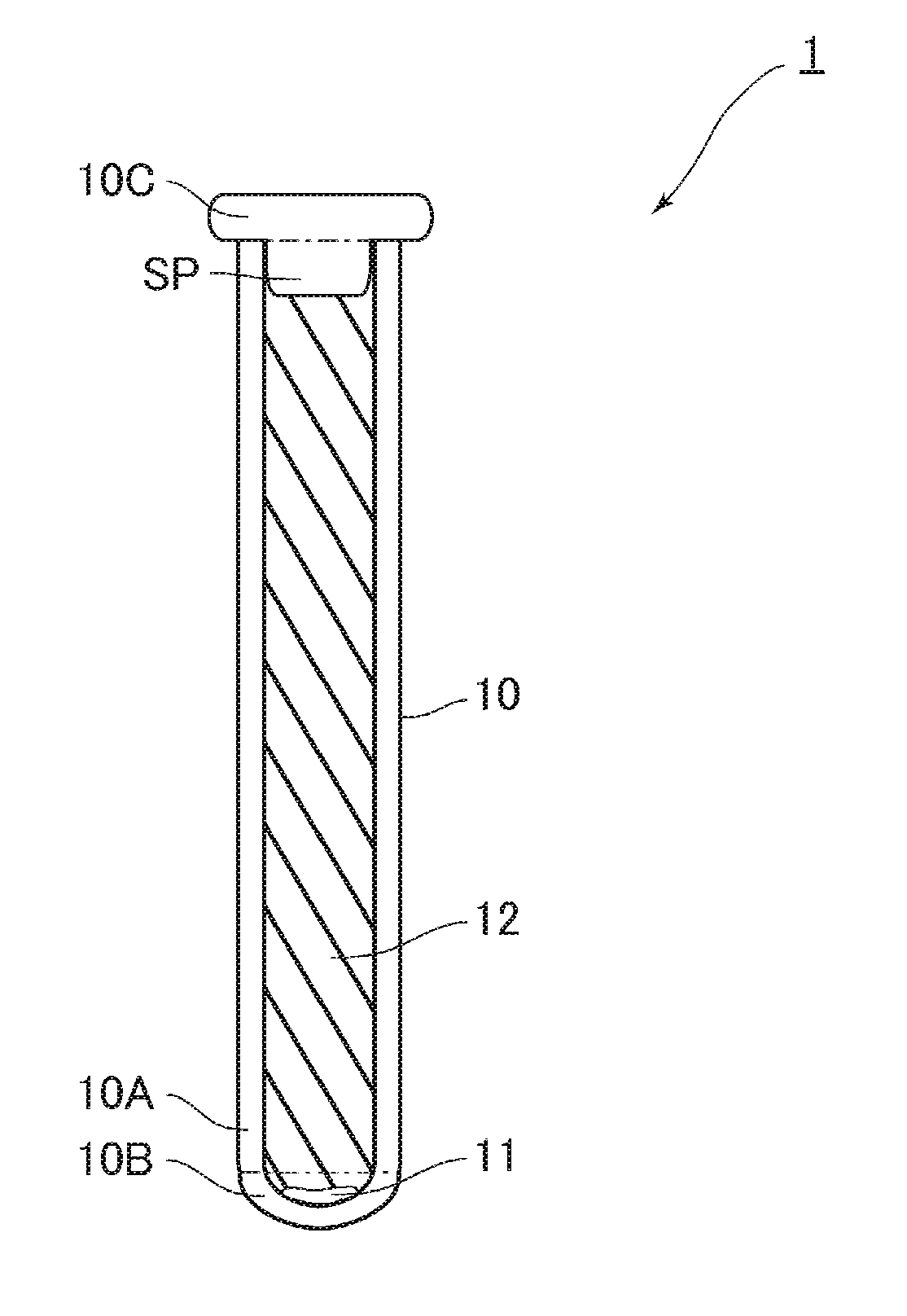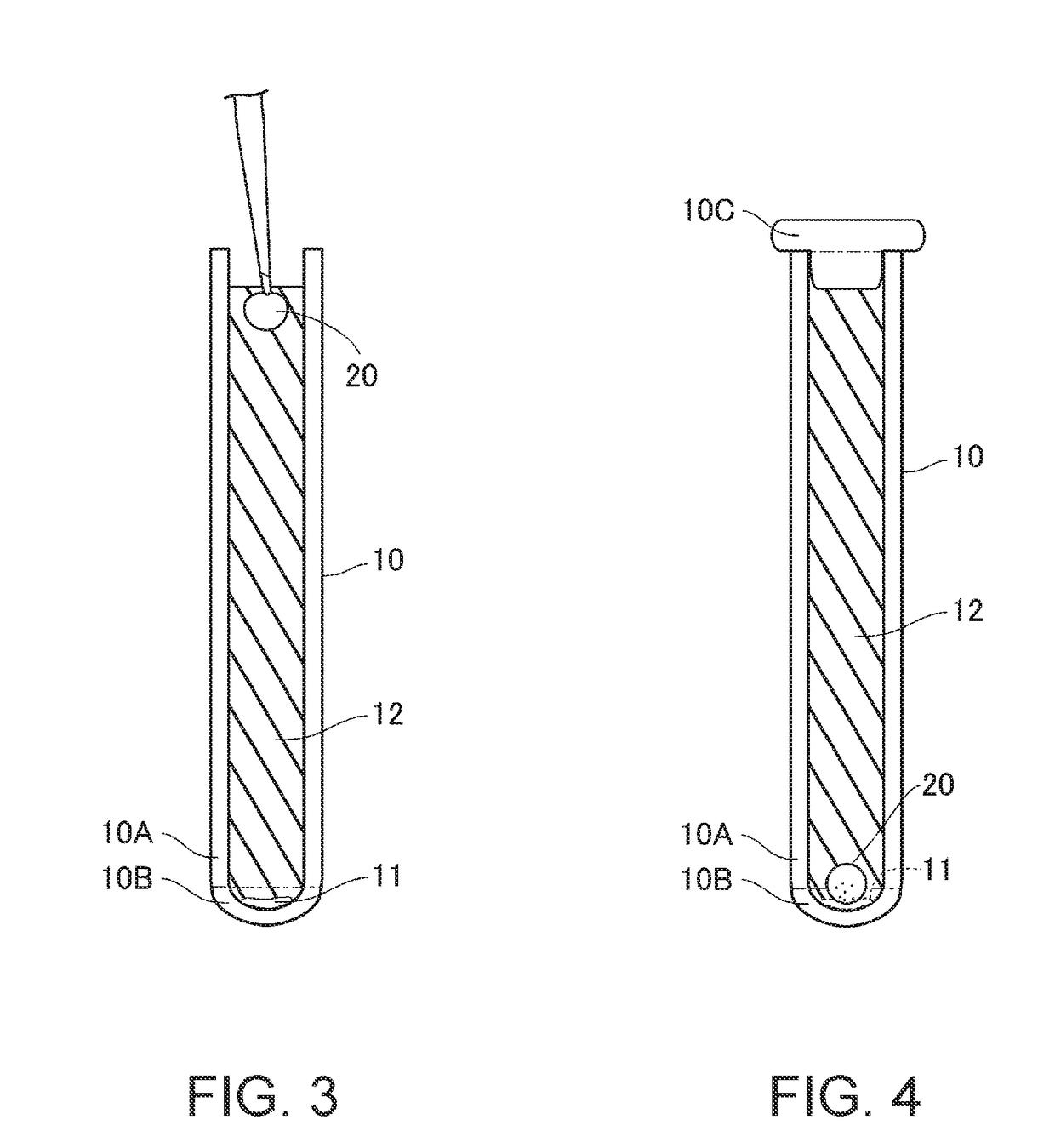Nucleic acid amplifier, cartridge for nucleic acid amplification and nucleic acid amplification method
a nucleic acid amplification and amplifier technology, applied in the field of nucleic acid amplifiers, can solve the problems of amplification efficiency drop, probes that cannot bind to template nucleic acids, and achieve the effect of stronger binding of probes and amplification efficiency drop
- Summary
- Abstract
- Description
- Claims
- Application Information
AI Technical Summary
Benefits of technology
Problems solved by technology
Method used
Image
Examples
example 1
[0088]First, a template nucleic acid, the reagent 11 used for amplification of a target nucleic acid in the template nucleic acid, and a positive control were charged into a test tube, and 10 μL of distilled water was added to prepare a template nucleic acid solution.
[0089]The mycoplasma pneumoniae genomic DNA (MBC035, 250 copies) available from Vircell was used as the template nucleic acid, and only 0.625 μL was charged into the test tube.
[0090]The Escherichia coli genomic DNA (9060, 750 fg / μL) available from Takara Bio was used as the positive control, and only 0.625 μL was charged into the test tube.
[0091]The Platinum Taq available from Life Technologies was used as the DNA polymerase contained in the reagent 11, and only 0.4 μL was charged into the test tube.
[0092]The dNTP purchased from Roche was used as the dNTP contained in the reagent 11, and only 0.54 μL was charged into the test tube.
[0093]A forward primer and a reverse primer were prepared as the primers contained in the ...
example 2
[0106]A template nucleic acid solution was prepared under the same conditions used in Example 1, except that a template nucleic acid, primers, and a probe different from those used in Example 1 were used.
[0107]The pertussis genomic DNA (MBC008, 200 copies) available from Vircell was used as the template nucleic acid of Example 2.
[0108]The primers for pertussis, and the fluorescently labeled probe for pertussis had the sequences shown in Table 3 below.
TABLE 3SEQ ID NO: 7Forward primer for pertussis5′ ATCCAGGTACGGGTGAAGACAC 3′SEQ ID NO: 8Reverse primer for pertussis5′ CGCATCAACAAGTCCTAGCGAAC 3′SEQ ID NO: 9Fluorescently labeled probe 5′ AM-AATGGCAAGGCCGAACGCTTCA-NFQ-for pertussisMGB 3′
[0109]The template nucleic acid solution was introduced into the container 10. After the liquid droplet 20 was formed inside the container 10, the container 10 was installed in the insertion hole 64 of the heating unit 65 of the nucleic acid amplifier 50, and the thermal cycle process and the amplificatio...
example 3
[0114]A template nucleic acid solution was prepared under the same conditions used in Example 1, except that a template nucleic acid, primers, and a probe different from the template nucleic acid, the positive control, the primers, and the probe used in Example 1 were used.
[0115]The adenovirus genomic DNA (MBC001, 100 copies) available from Vircell was used as the template nucleic acid of Example 3. The genomic DNA of culture-derived Bacillus subtilis was used as a positive control in Example 3.
[0116]The forward primers and the reverse primers for adenovirus and Bacillus subtilis, and the fluorescently labeled probe for adenovirus had the sequences shown in Table 5 below.
TABLE 5SEQ ID NO: 11Forward primer for adenovirus5′ GACATGACTTTCGAGGTCGATCCCATGGA 3′SEQ ID NO: 12Reverse primer for adenovirus5′ CCGGCTGAGAAGGGTGTGCGCAGGTA 3′SEQ ID NO: 13Forward primer for Bacillus subtilis5′ TGAAGGTGACGCTGAGTACG 3′SEQ ID NO: 14Reverse primer for Bacillus subtilis5′ TTTTTCAGTGTCGCGTTCTG 3′SEQ ID NO...
PUM
| Property | Measurement | Unit |
|---|---|---|
| Time | aaaaa | aaaaa |
| Time | aaaaa | aaaaa |
| Volume | aaaaa | aaaaa |
Abstract
Description
Claims
Application Information
 Login to View More
Login to View More - R&D
- Intellectual Property
- Life Sciences
- Materials
- Tech Scout
- Unparalleled Data Quality
- Higher Quality Content
- 60% Fewer Hallucinations
Browse by: Latest US Patents, China's latest patents, Technical Efficacy Thesaurus, Application Domain, Technology Topic, Popular Technical Reports.
© 2025 PatSnap. All rights reserved.Legal|Privacy policy|Modern Slavery Act Transparency Statement|Sitemap|About US| Contact US: help@patsnap.com



